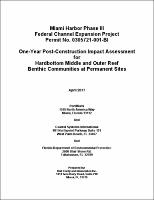Please use this identifier to cite or link to this item:
https://hdl.handle.net/11681/26449Full metadata record
| DC Field | Value | Language |
|---|---|---|
| dc.contributor.author | United States. Army. Corps of Engineers. Jacksonville District | - |
| dc.date.accessioned | 2018-02-13T14:42:03Z | - |
| dc.date.available | 2018-02-13T14:42:03Z | - |
| dc.date.issued | 2017-04 | - |
| dc.identifier.uri | http://hdl.handle.net/11681/26449 | - |
| dc.description.abstract | The Miami Harbor Phase III Deepening Project (Project) expanded the outer entrance channel to increase safe access to the PortMiami by larger class ships, including post-Panamax class ships. To accommodate these larger vessels, the outer entrance channel was widened at the outer reef and deepened to 52 (±1) feet Mean Lower Low Water (MLLW) (15.6 ± 0.3 m). Pre-construction avoidance and minimization of impacts to natural resources was conducted through the NEPA process and a Record of Decision was signed on May 22, 2006. The offshore portion of the project was deemed complete on April 8, 2015. The entire project was completed on September 17, 2015. The one-year post-construction impact assessment report for permanent sites (referred to as impact assessment throughout this report) documents the permanent and temporary impacts of the Project. The project was permitted through the Florida Department of Protection (FDEP), under Permit No. 0305721-001-BI. Permit conditions provided methods on environmental monitoring required before, during, and after dredging activities. The FDEP permit stated in Specific Condition 32 a ii. d: “Impacted areas shall continue to be monitored monthly during the construction, one month post-construction, and two times during the next year in order to document results of the impact. Final monitoring results shall document permanent impacts, if any, to be used for estimates of additional mitigation using UMAM.” This report documents the first of two monitoring efforts in the one-year post-construction period. Specifically, this report documents the effects of the project on benthic resources within permanent monitoring sites on hardbottom, middle and outer reefs adjacent to the outer entrance channel. In order to characterize impacts at channel-side sites, 19 of the 26 permanent sites were selected by FDEP for follow-up monitoring during the FDEP recommended impact assessment protocol (FDEP June 2016). These sites included 9 impacted channel-side sites and their respective controls (one site R2N1-RR, had two control sites). In the area of the norther middle reef control sites, three habitats were present (ridge reef (RR), linear reef (LR), and ridge reef (RR), see Figure 1), while channel-side only a single representative of each habitat type was present (RR and LR). A control site was set up at each of the northern control habitat types and monitored in baseline and post-construction surveys. Site selection by FDEP were sites with the greatest sedimentation related effects according to construction and post-construction period impact assessment surveys (DCA 2014b, DCA 2015a, Miller et al 2016). A second impact assessment survey is required by the FDEP permit and as of March 2017, field work for that effort is still ongoing. A number of parameters including benthic organism density, cover, and condition, as well as quantitative sedimentation rates were measured to test the null hypothesis. Ho: Benthic community structure and function in the indirect effect (channel-side) sites will remain unchanged between the baseline and one-year post-construction impact assessment surveys. During the project, the deposition of clay-like material at channel-side sites was documented during required compliance monitoring. At channel-side monitoring sites, this material resulted in the complete mortality of 6 scleractinian corals and the partial mortality of approximately 64.8% of the nine surveyed channel-side sites during the impact assessment survey. According to cover estimates an increase in sand was also documented between baseline and impact assessment surveys, with all sites trending towards baseline, in the one-year post-construction survey period. While sand increased at channel-side sites, living constituent cover of sponges, octocorals, and zoanthids did not change significantly between baseline and impact assessment surveys. The only living and non-living cover that declined substantially between baseline and impact assessment surveys was the other major space occupier besides sand, CTB (crustose coralline algae, turf algae and bare) cover, which declined by 15% across all surveyed channel-side sites. | en_US |
| dc.language.iso | en | en_US |
| dc.publisher | United States. Army. Corps of Engineers. Jacksonville District. | en_US |
| dc.subject | Port of Miami (Fla.) | en_US |
| dc.subject | Dredging | en_US |
| dc.title | Miami Harbor Phase III, Federal Channel Expansion Project, Permit No. 0305721-001-BI : One-Year Post-Construction Impact Assessment for Hardbottom Middle and Outer Reef Benthic Communities at Permanent Sites | en_US |
| dc.type | Report | en_US |
| Appears in Collections: | Environmental Documents | |
Files in This Item:
| File | Description | Size | Format | |
|---|---|---|---|---|
| PortMiami_Permanent_Site_Report_04_24_17.pdf | 28.13 MB | Adobe PDF |  View/Open |